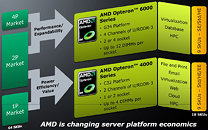Tuesday, February 23rd 2010

AMD Starts Shipping 12-core and 8-core ''Magny Cours'' Opteron Processors
AMD has started shipping its 8-core and 12-core "Magny Cours" Opteron processors for sockets G34 (2P-4P+), and C32 (1P-2P). The processors mark entry of several new technologies for AMD, such as a multi-chip module (MCM) approach towards increasing the processor's resources without having to complicate chip design any further than improving on those of the Shanghai and Istanbul. The new Opteron chips further make use of third-generation HyperTransport interconnect technologies for 6.4 GT/s interconnect speeds between the processor and host, and between processors on multi-socket configurations. It also embraces the Registered DDR3 memory technology. Each processor addresses memory over up to four independent (unganged) memory channels. Technologies such as HT Assist improve inter-silicon bandwidth on the MCMs. The processors further benefit from 12 MB of L3 caches on board, and 512 KB of dedicated L2 caches per processor core.
In the company's blog, the Director of Product Marketing for Server/Workstation products, John Fruehe, writes "Production began last month and our OEM partners have been receiving production parts this month." The new processors come in G34/C32 packages (1974-pin land-grid array). There are two product lines: the 1P/2P capable (cheaper) Opteron 4000 series, and 2P to 4P capable Opteron 6000 series. There are a total of 18 SKUs AMD has planned some of these are listed as followed, with OEM prices in EUR:
Sources:
AMD Blogs, TechConnect Magazine
In the company's blog, the Director of Product Marketing for Server/Workstation products, John Fruehe, writes "Production began last month and our OEM partners have been receiving production parts this month." The new processors come in G34/C32 packages (1974-pin land-grid array). There are two product lines: the 1P/2P capable (cheaper) Opteron 4000 series, and 2P to 4P capable Opteron 6000 series. There are a total of 18 SKUs AMD has planned some of these are listed as followed, with OEM prices in EUR:
- Opteron 6128 (8 cores) | 1.5 GHz | 12MB L3 cache | 115W TDP - 253.49 Euro
- Opteron 6134 (8 cores) | 1.7 GHz | 12MB L3 cache | 115W TDP - 489 Euro
- Opteron 6136 (8 cores) | 2.4 GHz | 12MB L3 cache | 115W TDP - 692 Euro
- Opteron 6168 (12 cores) | 1.9 GHz | 12MB L3 cache | 115W TDP - 692 Euro
- Opteron 6172 (12 cores) | 2.1 GHz | 12MB L3 cache | 115W TDP - 917 Euro
- Opteron 6174 (12 cores) | 2.2 GHz | 12MB L3 cache | 115W TDP - 1,078 Euro

125 Comments on AMD Starts Shipping 12-core and 8-core ''Magny Cours'' Opteron Processors
There's a company with 100 core CPUs already clocked at 1.8ghz each : /
Once they've sorted out how an OS can actually interact with such a CPU that will be fun and games : ]
( obviously not the 100 core version, I imagine heat would melt everything ha ha)
No money for this crap anymore. I'm gonna ride my i7 rig for years then pick up whatever Console is out at the time.
So i'm out.*throws cards down on table*
Mind you, there's plenty of overhead associated with such an operation, but I think the point stands. In my mind, AMD will do well with these... They're no speed demon, but that's not what the industry is looking for right now.
The H8SGL-F that I posted was displayed at Supermicro's SC09 booth.
And with btarunr's statement wouldn't the overhead that was in intel's MCM design be non existant or dam near gone?
Basically, this fad of adding more cores, if it lasts too long, will be bad for developers and consumers. Yes, it's nice to have extra cores to offload work but that doesn't change the fact a 12 GHz CPU can handle more work than a 4 x 3 GHz CPU because of having no overhead.
In order to maintain Moore's Law much longer, semiconductor has to leap ahead of where it is today.
In terms of MCM, it really doesn't matter as demonstrated by Phenom compared to Core 2 Quad.
The human brain (the most powerful computer known) is massively parallel.
Improving per-core performance is still extremely important, and I don't think AMD or Intel are abandoning that in favor of just increasing core count. Look at the per-core difference between C2D and Core lines of CPUs.
Anyway, mainstream multi-core computing is still in its infancy. The main issue seems to be software algorithms and implementation, not some flaw with the concept of multiple CPU cores itself. There will be challenges in the future, such as the jump from multi-core to many-core CPUs, but I see no signs that multi-core computing is a dead end.